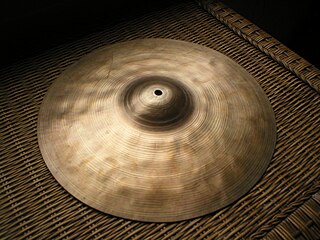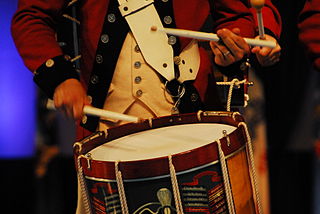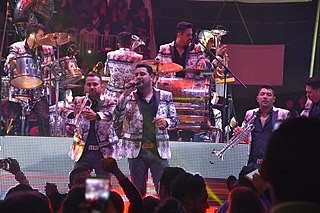See also
| This disambiguation page lists articles associated with the title Cymbal. If an internal link led you here, you may wish to change the link to point directly to the intended article. |
Cymbal and similar can mean:
| This disambiguation page lists articles associated with the title Cymbal. If an internal link led you here, you may wish to change the link to point directly to the intended article. |

A cymbal is a common percussion instrument. Often used in pairs, cymbals consist of thin, normally round plates of various alloys. The majority of cymbals are of indefinite pitch, although small disc-shaped cymbals based on ancient designs sound a definite note. Cymbals are used in many ensembles ranging from the orchestra, percussion ensembles, jazz bands, heavy metal bands, and marching groups. Drum kits usually incorporate at least a crash, ride, or crash/ride, and a pair of hi-hat cymbals. A player of cymbals is known as a cymbalist.

A drum kit — also called a drum set, trap set, or simply drums — is a collection of drums and other percussion instruments, typically cymbals, which are set up on stands to be played by a single player, with drumsticks held in both hands, and the feet operating pedals that control the hi-hat cymbal and the beater for the bass drum. A drum kit consists of a mix of drums and idiophones – most significantly cymbals, but can also include the woodblock and cowbell. In the 2000s, some kits also include electronic instruments. Also, both hybrid and entirely electronic kits are used.

A percussion instrument is a musical instrument that is sounded by being struck or scraped by a beater including attached or enclosed beaters or rattles struck, scraped or rubbed by hand or struck against another similar instrument. The percussion family is believed to include the oldest musical instruments, following the human voice.

The Avedis Zildjian Company, simply known as Zildjian, is an Armenian-American musical instrument manufacturer and the largest cymbal and drumstick maker in the world. The company was founded in Constantinople by Avedis Zildjian in 1623, and is now based in Norwell, Massachusetts. Zildjian is one of the oldest manufacturers of musical instruments in the world. Zildjian sells cymbals, drumsticks, percussion mallets and other drum accessories under the Zildjian, Vic Firth and Balter Mallet brands.
Animusic is an American company specializing in the 3D visualization of MIDI-based music. Founded by Wayne Lytle, it is incorporated in New York, with offices in Texas and California. The initial name of the company was Visual Music, but changed to Animusic in 1995.

Clash cymbals are cymbals played in matched pairs by holding one cymbal in each hand and striking the two together.

Zills, also zils or finger cymbals, are small metallic cymbals used in belly dancing and similar performances. They are called sājāt (صاجات) in Arabic. They are similar to Tibetan tingsha bells. In western music, several pairs of zills can be set in a frame to make a tambourine.

A drumline, also known as the battery or batterie, is a section of percussion instruments usually played as part of a musical marching ensemble. A drumline can also be a section on their own competing against other drumlines. Marching bands, drum and bugle corps, and indoor percussion ensembles are some examples of groups that include a drumline.

Marching percussion instruments are specially designed to be played while moving. This is achieved by attaching the drum(s) to a special harness worn by the drummer, although not all marching bands use such harnesses and instead use traditional baldrics to sling their drums. The drums are designed and tuned for maximum articulation and projection of sound, as marching activities are almost always outdoors or in large interior spaces. Articulation is paramount to producing a "clean" sound from all the drummers in the line. These instruments are used by marching bands, drum and bugle corps, indoor percussion ensembles, and pipe bands. A marching percussion ensemble is frequently known as a drumline or battery.

An electronic drum is a modern electronic musical instrument, primarily designed to serve as an alternative to an acoustic drum kit or other percussion instruments. An electronic drum consists of an electronic or digital sound module which produces the synthesized or sampled percussion sounds and one or more electric sensors or sensor-equipped pads to trigger the sounds. Like regular drums, the sensors or pads are struck by drum sticks or by the hands and they are played in a similar manner to an acoustic drum kit.

In a marching band or a drum and bugle corps, the front ensemble or pit is the stationary percussion ensemble. This ensemble is typically placed in front of the football field, though some groups will work the front ensemble into a tight pod onto the marching field. Some high school marching bands opt not to march any percussion instruments, but instead have a "full" front ensemble.

Banda is a term to designate a genre of Regional Mexican music and the musical ensemble in which wind instruments, mostly of brass and percussion, are performed.
Orchestral percussion are percussion instruments used in orchestras and concert bands mainly in classical music and related styles. The term can also refer to the department or study of performance on said instruments at a music school or conservatory. Generally within such a department, students are required to study all aspects of orchestral playing; with marimba, snare drum, and timpani being the three most basic areas of study. Orchestral percussion usually does not include a drum set, but some compositions do require one.
Cymbal manufacturers refer to companies and/or individuals who primarily manufacture and/or ship cymbals, bells, gongs, or any other metallic percussion item of that type, be it B8 or B20, mass produced or boutique, ride, crash, splash, or hi-hat, for use by percussionists, drummers, and other musicians.

Martial music or military music is a specific genre of music intended for use in military settings performed by professional soldiers called field musicians. Much of the military music has been composed to announce military events as with bugle calls and fanfares, or accompany marching formations with drum cadences, or mark special occasions as by military bands. However, music has been employed in battle for centuries, sometimes to intimidate the enemy and other times to encourage combatants, or to assist in organization and timing of actions in warfare. Depending on the culture, a variety of percussion and musical instruments have been used, such as drums, fifes, bugles, trumpets or other horns, bagpipes, triangles, cymbals, as well as larger military bands or full orchestras. Although some martial music has been composed in written form, other music has been developed or taught by ear, such as bugle calls or drum cadences, relying on group memory to coordinate the sounds.

In percussion, cymbal choke is a drum stroke or push which consists of striking a cymbal with a drum stick held in one hand and then immediately grabbing the cymbal with another hand, or more rarely, with the same hand. The cymbal choke produces a burst of sound which is abruptly silenced, which can be used for punctuation or dramatic fortissimo effects. In some modern music, namely heavy metal, it is "often employed to emphasize a particular beat or signal an abrupt conclusion to a passage." Cymbal chokes are used extensively by classical percussionists to muffle the sound of a cymbal in accordance with the composer's notation, or in an attempt to match the sustain of other instruments in the ensemble. "The effect, a sudden burst of sound, is [often] further strengthened by a single, simultaneous kick with the bass drum."
For 'choke' cymbal, strike the suspended cymbal with the tip of a wood stick and dampen the sound immediately after the duration of the note.
[In] ragtime [1890-1920]...a lot of time there would be a crash cymbal, or a choke cymbal as they called it, that was usually played with a mallet. They would strike the cymbal with one hand and choke it with the other hand. And there were different techniques for choking the cymbals. Sometimes, they would really cut the cymbal and make it real staccato...Or they would play other styles where they would let the cymbal ring a little bit and sustain itself, and then catch it.

The percussion section is one of the main divisions of the orchestra and the concert band. It includes most percussion instruments and all unpitched instruments.

The taal, manjira, jalra, or gini is a pair of clash cymbals, originating in the Indian subcontinent, which make high-pitched percussion sounds. In its simplest form, it consists of a pair of small hand cymbals. The word taal comes from the Sanskrit word Tālà, which literally means a clap. It is a part of Indian music and culture, used in various traditional customs e.g. Bihu music, Harinaam etc.It is a type of Ghana vadya.

Heavy metal drumming is a style of rock music drum kit playing that developed in the late 1960s and early 1970s, largely in the United Kingdom and the United States. With roots in blues rock and psychedelic/acid rock drum playing, heavy metal drummers play with emphatic beats, and overall loudness using an aggressive performing style. Heavy metal drumming is traditionally characterized by emphatic rhythms and dense bass guitar-and-drum sound. The essence of metal drumming is creating a loud, constant beat for the band using the "trifecta of speed, power, and precision".